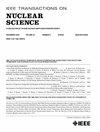Advanced Prognostics and Health Management for Distributed Plasma Control Systems: A Stochastic Timed Colored Petri Net and Machine Learning-Based Approach
IF 1.9
3区 工程技术
Q3 ENGINEERING, ELECTRICAL & ELECTRONIC
引用次数: 0
Abstract
The LingShu plasma control system (PCS) is a distributed, real-time control system designed for tokamak control, featuring a modular architecture and adaptability to heterogeneous hardware. To enhance its reliability and stability, a prognostics and health management (PHM) component was implemented to address health maintenance challenges in distributed environments, where unplanned downtimes can cause delays, data loss, and equipment damage. The PHM component spans the full PCS lifecycle, playing key roles in development, operation, and maintenance phases. During development, a stochastic timed colored Petri net (STCPN) model was introduced to simulate the behavior of complex real-time systems, identifying race conditions and deadlocks in the design phase. This marks the first use of STCPN in fusion control systems, strengthening system robustness and reliability. In operation, the PHM component integrates real-time monitoring, fault diagnosis, and prediction, leveraging LingShu’s modular and plugin-based design for flexible subsystem adaptation. It evaluates system health and reminds PCS to take actions, such as algorithm switching, to ensure stability and minimize downtime. During maintenance, detailed logs and visualization interfaces enable rapid fault localization and troubleshooting, reducing downtime and costs. The PHM component employs decision table-based fault diagnosis, analytic hierarchy process (AHP) inspired health evaluation, and long short-term memory (LSTM) models for resource usage prediction. This approach addresses challenges like resource fluctuations from algorithm switching and “closed box” algorithms, offering dynamic health evaluation standards to enhance monitoring accuracy and system adaptability. Deployed during the 2024 EAST campaign, the PHM component operated continuously, supporting PCS reliability and demonstrating its potential in fusion research.分布式等离子体控制系统的先进预测和健康管理:随机定时彩色Petri网和基于机器学习的方法
灵树等离子体控制系统(PCS)是为托卡马克控制而设计的分布式实时控制系统,具有模块化结构和对异构硬件的适应性。为了增强其可靠性和稳定性,实现了一个预测和健康管理(PHM)组件,以解决分布式环境中的健康维护挑战,在分布式环境中,计划外停机可能导致延迟、数据丢失和设备损坏。PHM组件跨越整个pc生命周期,在开发、操作和维护阶段发挥关键作用。在开发过程中,引入了随机定时彩色Petri网(STCPN)模型来模拟复杂实时系统的行为,识别设计阶段的竞争条件和死锁。这标志着STCPN在融合控制系统中的首次使用,增强了系统的鲁棒性和可靠性。在运行中,PHM组件集成了实时监测、故障诊断和预测,利用灵树的模块化和插件设计,灵活地适应子系统。它评估系统的健康状况,并提醒pc采取相应的行动,如算法切换,以确保稳定性和最大限度地减少停机时间。在维护过程中,详细的日志和可视化界面使故障快速定位和故障排除,减少停机时间和成本。PHM组件采用基于决策表的故障诊断、层次分析法(AHP)启发的健康评估和长短期记忆(LSTM)模型进行资源使用预测。该方法解决了算法切换和“封闭盒”算法带来的资源波动等挑战,提供了动态健康评估标准,以提高监测准确性和系统适应性。PHM组件在2024年EAST战役中部署,持续运行,支持pc的可靠性,并展示了其在聚变研究中的潜力。
本文章由计算机程序翻译,如有差异,请以英文原文为准。
求助全文
约1分钟内获得全文
求助全文
来源期刊

IEEE Transactions on Nuclear Science
工程技术-工程:电子与电气
CiteScore
3.70
自引率
27.80%
发文量
314
审稿时长
6.2 months
期刊介绍:
The IEEE Transactions on Nuclear Science is a publication of the IEEE Nuclear and Plasma Sciences Society. It is viewed as the primary source of technical information in many of the areas it covers. As judged by JCR impact factor, TNS consistently ranks in the top five journals in the category of Nuclear Science & Technology. It has one of the higher immediacy indices, indicating that the information it publishes is viewed as timely, and has a relatively long citation half-life, indicating that the published information also is viewed as valuable for a number of years.
The IEEE Transactions on Nuclear Science is published bimonthly. Its scope includes all aspects of the theory and application of nuclear science and engineering. It focuses on instrumentation for the detection and measurement of ionizing radiation; particle accelerators and their controls; nuclear medicine and its application; effects of radiation on materials, components, and systems; reactor instrumentation and controls; and measurement of radiation in space.
 求助内容:
求助内容: 应助结果提醒方式:
应助结果提醒方式:


